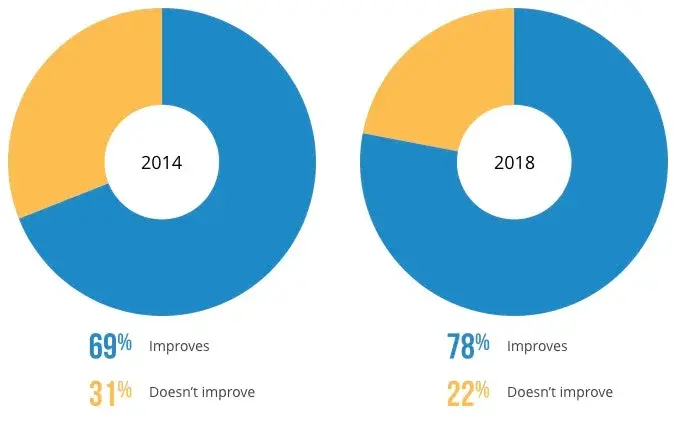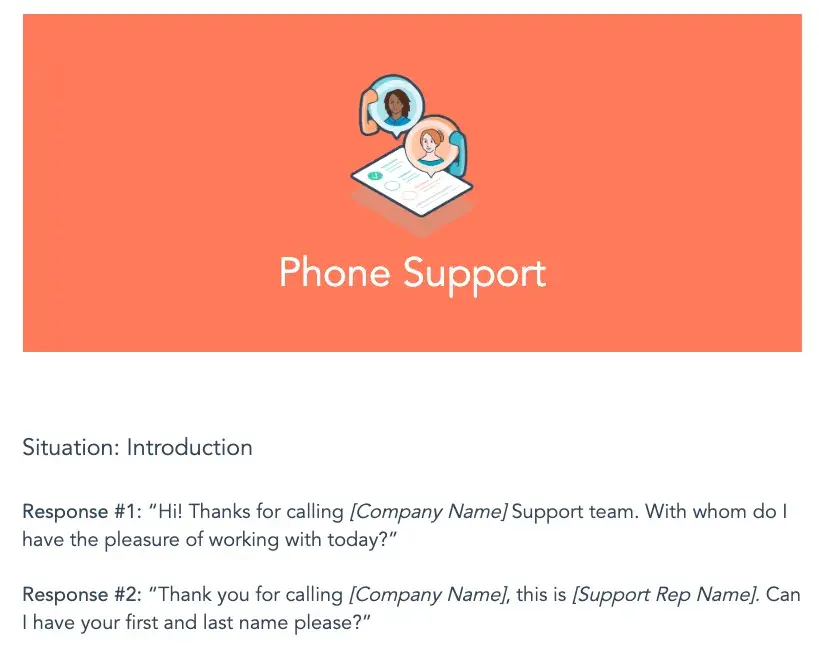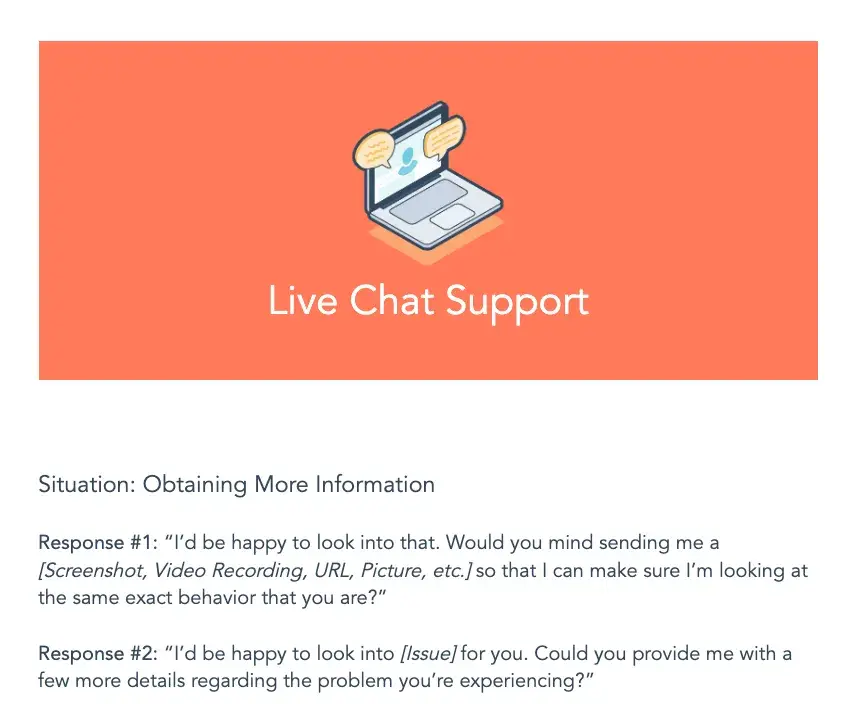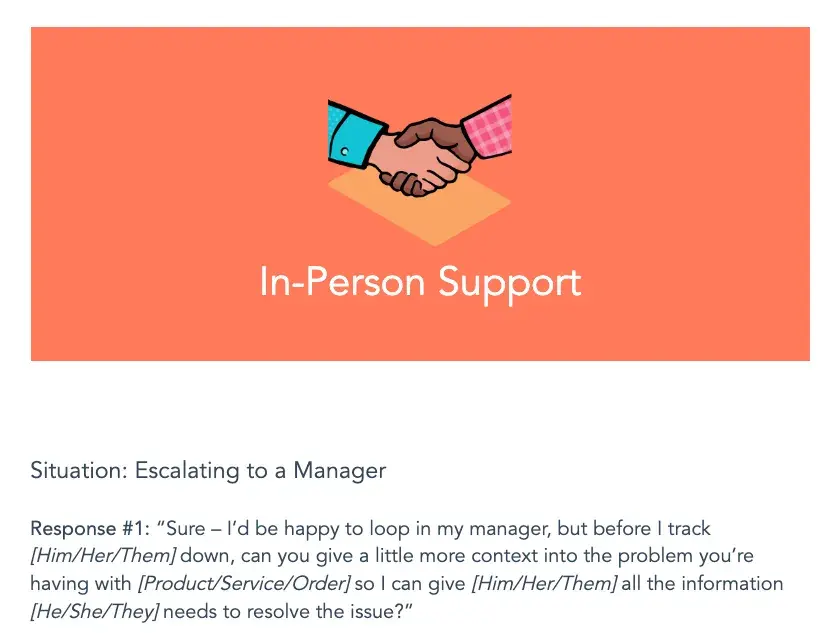That’s where positive scripting comes in. Positive scripting is a method of steering and reframing customer conversations towards positivity and productivity.
While I didn’t use strict positive scripting in the form of canned responses, I learned that what you say and how you say it matters greatly. I learned to transform even the most challenging situations into pleasant, efficient outcomes by carefully selecting my language.
I put together some positive scripting examples and best practices to help you keep customer conversations on the right track. Let’s go!
Table of Contents
- What Is Positive Scripting?
- Best Practices for Positive Scripting for Customer Service
- Positive Scripting for De-Escalation
- Positive Scripting for More Authentic Customer Communication
- Customer Service Script Template
- Empathetic Customer Services Starts with Positive Language
What Is Positive Scripting?
Positive scripting in customer service is the process of using pre-determined phrases and responses to ease customer frustration and achieve a pleasant, efficient conversational outcome.
You might be wondering, “Does this actually work?”
Well, it's complicated.
As a customer, I can tell when a rep is being disingenuous. I find that positive scripting can be inauthentic if there isn’t genuine empathy behind the words.
The 2023 Customer Rage Survey found that customers often feel dissatisfied when they receive scripted responses from support reps. In fact, 69% of customers prefer personalized, empathetic interactions over scripted ones.

Customers dislike being met with inauthentic canned responses, but does that mean there's no room for positive scripting and scripting exercises in your approach to customer success?
Not entirely.
Benefits of Positive Scripting
Finding the right words when working with a frustrated customer can be challenging. Trust me, I’ve been there. Positive scripting can empower reps with phrases and methods to reframe a tough conversation instead of feeling obligated to walk on eggshells.
Regarding transactional requests, you can use scripts to streamline communication and help you quickly get the customer what they need. For example, if a customer requests to return an item, you might consider the following script:
“I’ve generated a return shipping label for you. You’ll receive an email with the label shortly. Please print it and attach it to the package. Is there anything else I can assist you with today?”
I wasn’t required to use strict positive scripting as a support rep. However, I did receive extensive training in working with frustrated customers, including strategies for de-escalation. Although my responses weren’t strictly scripted, training in this area gave me the conversational tools and fallbacks to handle heightened scenarios.
Negative Aspects of Positive Scripting
In most cases, customers are privy to whether the response they hear is scripted. I’ve been there, and I’m sure you have, too (ever try to cancel a gym membership?). If you’re not careful, overreliance on scripts can lead to insincere interactions, which makes customers feel undervalued.
Additionally, leaning too heavily on scripts can imply that the rep isn’t experienced or capable enough to help. I find that positive scripting can backfire if it’s used as a crutch.
Hopefully, your organization has a loose approach toward scripts and allows you to use them as a guiding light toward successful interaction, not something that must be followed to a T.
Best Practices for Positive Scripting for Customer Service
Use Scripts as a Training Tool
Scripts can be a valuable training tool for new employees, giving them a foundation for handling customer interactions. Scripts serve as a starting point, helping new service professionals learn the ropes and better understand the flow of positive customer interaction.
As a rookie support rep, I underwent various training exercises, including mock calls and actual calls, where an experienced team member shadowed me. While I wasn’t given a specific script I had to adhere to, I was guided through strategies and best practices for attaining positive customer interactions. It's kind of like a loose script if you will.

Using loose, positive scripting in training gave me confidence and strategies to fall back on during customer interactions. In my experience, scripts are best when used lightly as a guide for conversation you can riff on, as opposed to something that must be recited word for word.
Pro tip: To prevent dependency on scripts, consider providing new reps with general bullet points or loose phrases to help guide the conversation instead of lengthy scripts that must be followed to the letter.
Remember, You’re Talking to a Person
As a service rep, it is unfortunately easy to lose sight of the fact that the customer is simply a person just like you or anybody else. Remembering this when speaking over the phone, email, social media, or any other medium that lacks face-to-face contact is vital.
Accordingly, before falling back on a canned response, take a moment to ask yourself: “Would I say this to a customer's face?”
Think about it. What sounds more natural to you?
- “It's our policy to take down this information before we get started. I understand how you feel, but that's all we can do.”
Or:
- “Here's what I can do to make this easier for you. Let's start by taking some information down.”
Notice the difference? The second response feels more personal. At its core, it communicates the same message as the first response – but it's much more human.
If you want to create resonance with a customer, don't hesitate to improvise and empathize.
Consider Reducing Restrictive Scripts
Suppose strict adherence to scripts is enforced at your organization, which hinders your ability to empathize with customers and reach positive outcomes. In that case, you should raise concerns with upper management.
We had an open and supportive company culture when I worked at HubSpot Support. If any representative (regardless of tenure) had an idea or suggestion on improving things, they were encouraged to express it. Hopefully, your company culture is similar, and you can begin a conversation around the restrictive use of positive scripts.
According to an annual shareholder letter from Jeff Bezos, companies should be focused on customer outcomes, not just processes. Because when you pour all of your energy into the process, you no longer focus on the result — customer satisfaction. You become so involved in doing it right that you miss the mark.
If you're feeling limited by scripts and canned responses, start a conversation with leadership about the benefits of having more agile conversations with customers — just be sure to come prepared with solutions rather than a list of complaints.
Avoid Letting Scripts Hinder Empathy
Focus on teaching your employees the importance of empathy. Genuine empathy allows you to connect with customers and work towards a common goal instead of just regurgitating a solution to their issue.
To cultivate empathy, you’ll need to actively listen to customer concerns and let your interaction come from a genuine understanding of their position. This is easier said than done, of course, and it’s nearly impossible if you don’t have the freedom to go a bit off-script to create a personalized conversational environment.
Use Positive Language
I mentioned earlier that positive scripting keeps unsteady customer interactions from going south, but an entire script isn't necessary in many cases.
Rather than filling the conversation with a bunch of affirmative comebacks and quips (read: robotic jargon), try leaning on a few powerful, positive words instead.
“Customers don’t care about your policies. Find and engage the need. Tell the customer what you can do.” – Alice Sesay Pope
Need inspiration? Here are a few suggested words to pull in when you need to inspire confidence.

Remember: Use these terms wisely. Over-use of positive words can come off as disingenuous.
Positive Scripting for De-Escalation
De-escalation is the process of reducing the intensity or conflict within a customer interaction. De-escalation is crucial when dealing with a frustrated or angry customer.
Often, the customer is rightfully upset, and it is your job to validate their frustrations and carve a path forward together.
When I worked in support, some of the most challenging customer interactions came when we experienced product downtime. In these cases, I could only wait until the dev team squashed the bug. Of course, this was frustrating for customers who needed to use our product to do their jobs.
I spoke with many justifiably angry customers during times like these, and I learned that I could transform a difficult conversation into a positive one through empathetic, honest communication. The key is leveling with customers. Be honest, validate their concerns, and tell them you genuinely want to help.
Here are some examples of positive scripts that can help de-escalate challenging situations with customers.
Acknowledge and Empathize
The worst thing you can do to a frustrated customer is dodge accountability. If I made a mistake, I would admit it honestly and focus on the way forward. Denying any wrongdoing is a sure-fire recipe for an explosive conversation, in a bad way.
Here are some phrases to consider:
- “I understand why you are upset, and I’m here to help resolve this for you.”
- “I see how frustrating this is, and I truly apologize. Let’s work together to see how we can fix it.”
- “I know this is frustrating; I would be upset if I were in your position, too.”
Offer Solutions
Once you have acknowledged the customer’s concern, it’s time to figure out a way forward. Setting expectations properly and only offering solutions you can provide is essential.
Here are some helpful phrases:
- “Let’s take a look at the options we have to resolve this issue.”
- “I know this has been a difficult situation, but here is what I can do for you right now.”
- “Unfortunately, I’m unable to provide you with that specific service. However, here is how we can help you out.”
Stay Calm and Positive
As the customer service rep, you must maintain a positive tone in any interaction, especially escalated ones. I’ve found that a little bit of gratitude goes a long way.
Here are some positive phrases you might incorporate:
- “I appreciate you bringing this to our attention. I will do everything in my power to ensure it gets sorted.”
- “Thank you so much for your patience. Let’s work together to find a solution.”
- “I appreciate you hanging in there with me during this. I will make sure we take care of you, no matter what.”
Positive Scripting for More Authentic Customer Communication
LiveChat’s Olga Kolodynska explains: “Having standards and procedures have many benefits in terms of quality control and developing a consistent customer experience. Yet, companies need [to] assess the value of consistency versus the advantages of allowing or promoting a more human, personalized customer service conversation.”
Regarding positive scripting, I’d argue that this perspective is spot on. While quality and consistency are critical measures of customer experience, achieving success in these areas without scripting all of your interactions is possible.
A solid first step? Empowering those in customer-facing roles to make decisions, improvise, and use good judgment.
Customer Service Script Template
Customer service scripts can be used for a good purpose. But, I believe the key is to take a positive approach to each customer interaction and know when to ditch the script.
Below are a few of the most natural scripts for customer service teams. They’re customizable so that you can adjust them for your personality and your company’s brand.
Free Resource: 45 Customer Service Script Templates
1. Phone Support

If you take most of your support inquiries via phone calls, this phone support script template is beneficial. It covers everyday activities on support calls, like making introductions, placing a customer on hold, transferring calls, and more.
2. Email Support

Like live chat, email is text-based, making it challenging to convey genuine, empathetic support to customers. These templates give thoughtful, helpful responses to customer issues that feel sincere and authentic.
3. Live Chat Support

Supporting customers via live chat comes with its own distinct challenges. You don’t have the luxury of using your voice to communicate empathy, and it’s more challenging to understand your customer’s mood. Additionally, live chat support must be quick, so you can’t spend too much time wordsmithing your customer responses.
Use this live chat support template to keep your responses quick and helpful during every customer interaction.
4. Social Media Support

Omni-channel experiences are becoming more popular — customers aren’t limiting their inquiries to phone calls or support emails.
Now, they’re going to social media for customer support. So, whether your marketing team disseminates inquiries to the customer service team or they handle these questions themselves, both teams will benefit from this social media support template. It covers transferring the customer to the support team and responding to negative feedback.

If you work in a setting with face-to-face contact with customers, you’ll want to print this template and keep it nearby. “Can I speak to the manager?” is a go-to phrase for many customers, but you don’t want to be that service rep who calls them in for every complaint.
These templates help you refocus the conversation to recommend a solution — preferably one that doesn’t involve your manager.
Empathetic Customer Services Starts with Positive Language
The biggest takeaway from my experience as a customer support rep is that customers are people, too. Not only are they people, but I believe in viewing them as teammates or friends who you are genuinely invested in helping.
I find that if you can tap into a genuine sense of empathy and understanding of the customer’s point of view, the correct language will come naturally.
Positive scripts are a helpful starting point, especially for new reps looking to build their repertoire of functional language. However, there is no substitute for strengthening that empathy muscle over time. Once you’ve crafted your mindset into one of empathy and understanding, the positive scripts will write themselves.
Editor's note: This post was originally published in April 2020 and has been updated for comprehensiveness.
.png?width=112&height=112&name=Image%20Hackathon%20%E2%80%93%20Vertical%20(5).png)

.png)


![24 best contact us pages you'll want to copy [+ templates]](https://53.fs1.hubspotusercontent-na1.net/hubfs/53/contact-us-page-1-20251028-243229.webp)

![How to Respond to Customer Complaints [+Complaint Response Examples]](https://53.fs1.hubspotusercontent-na1.net/hubfs/53/Copy%20of%20Featured%20Image%20Template%20Backgrounds%20(8)-1.png)


![How to Write an Apology Letter to Customers [12 Templates & Examples]](https://53.fs1.hubspotusercontent-na1.net/hubfs/53/ai%20customer%20service%20predictions%20(6).png)


